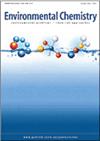Complexes of humic acid with cationic surfactants support the supramolecular view of extracted humic matter
IF 2.3
4区 环境科学与生态学
Q3 CHEMISTRY, ANALYTICAL
引用次数: 2
Abstract
Environmental context The molecular organisation of humic substances is key to understanding various natural and engineered processes, such as metal speciation and bioavailability. Two main models have been proposed: polymeric organisation and supramolecular organisation. A physicochemical approach, based on the interaction of humic acid with increasing amounts of cationic surfactants, leads to a sequence of molecular structures that provides support to the supramolecular view of humic organisation. Abstract The structural organisation of extracted humic matter, polymeric or supramolecular, has been a long-standing controversial issue. In this paper, we show that the interaction between a reference humic material, the Suwannee River Humic Acid (SRHA), and a homologous series of cationic surfactants (n-alkyl trimethyl ammonium chloride) provides key insights to resolve the controversy. By combining measurements of turbidity, electrophoretic mobility, surface tension and cryogenic transmission electron microscopy, we show that: (i) the binding of cationic surfactant to the anionic humic acid is initially triggered by electrostatic interactions; (ii) the contrasting evolution of turbidity–surfactant concentration curves implies that the surfactant alkyl chain interacts with the hydrophobic moieties of humic matter from very low concentrations of surfactant; (iii) a drastic restructuring of humic matter occurs on surfactant binding, which brings out supplementary anionic humic sites; (iv) in the presence of C12 cationic surfactant, SRHA spontaneously forms stable nanoscale unilamellar vesicles, which, in addition to the high surface activity of complexes, could be of interest in the remediation of oil-contaminated environments; (v) the sequence of molecular structures obtained from SRHA with increasing amounts of C12-cationic surfactant – humic-rich vesicles, aggregates, surfactant-rich vesicles – bears striking similarities with the phase behaviour of aqueous mixtures of anionic and cationic surfactants, thus supporting the supramolecular view of humic structure.腐植酸与阳离子表面活性剂的配合物支持提取腐植酸物质的超分子观点
腐殖质的分子组织是理解各种自然和工程过程的关键,如金属形态和生物利用度。提出了两种主要的模型:聚合物组织和超分子组织。一种基于腐植酸与越来越多的阳离子表面活性剂相互作用的物理化学方法,导致了一系列的分子结构,为腐植酸组织的超分子观点提供了支持。摘要萃取腐植质是聚合物还是超分子,其结构组织一直是一个有争议的问题。在本文中,我们证明了参考腐植酸,Suwannee河腐植酸(SRHA)和同源系列阳离子表面活性剂(n-烷基三甲基氯化铵)之间的相互作用为解决这一争议提供了关键的见解。通过结合浊度,电泳迁移率,表面张力和低温透射电镜的测量,我们表明:(i)阳离子表面活性剂与阴离子腐植酸的结合最初是由静电相互作用触发的;(ii)浊度-表面活性剂浓度曲线的对比演化表明,表面活性剂烷基链与来自极低浓度表面活性剂的腐殖质疏水部分相互作用;(iii)表面活性剂结合腐殖质发生剧烈的重组,产生补充的阴离子腐殖质位点;(4)在C12阳离子表面活性剂的存在下,SRHA自发形成稳定的纳米级单层囊泡,除了具有高表面活性的配合物外,还可以用于石油污染环境的修复;(v)随着c12阳离子表面活性剂用量的增加,从SRHA中得到的分子结构序列——富腐殖质囊泡、聚集体、富表面活性剂囊泡——与阴离子和阳离子表面活性剂水溶液混合物的相行为惊人地相似,从而支持腐殖质结构的超分子观点。
本文章由计算机程序翻译,如有差异,请以英文原文为准。
求助全文
约1分钟内获得全文
求助全文
来源期刊

Environmental Chemistry
环境科学-分析化学
CiteScore
4.50
自引率
0.00%
发文量
0
审稿时长
2.7 months
期刊介绍:
Environmental Chemistry publishes manuscripts addressing the chemistry of the environment (air, water, earth, and biota), including the behaviour and impacts of contaminants and other anthropogenic disturbances. The scope encompasses atmospheric chemistry, geochemistry and biogeochemistry, climate change, marine and freshwater chemistry, polar chemistry, fire chemistry, soil and sediment chemistry, and chemical aspects of ecotoxicology. Papers that take an interdisciplinary approach, while advancing our understanding of the linkages between chemistry and physical or biological processes, are particularly encouraged.
While focusing on the publication of important original research and timely reviews, the journal also publishes essays and opinion pieces on issues of importance to environmental scientists, such as policy and funding.
Papers should be written in a style that is accessible to those outside the field, as the readership will include - in addition to chemists - biologists, toxicologists, soil scientists, and workers from government and industrial institutions. All manuscripts are rigorously peer-reviewed and professionally copy-edited.
Environmental Chemistry is published with the endorsement of the Commonwealth Scientific and Industrial Research Organisation (CSIRO) and the Australian Academy of Science.
 求助内容:
求助内容: 应助结果提醒方式:
应助结果提醒方式:


